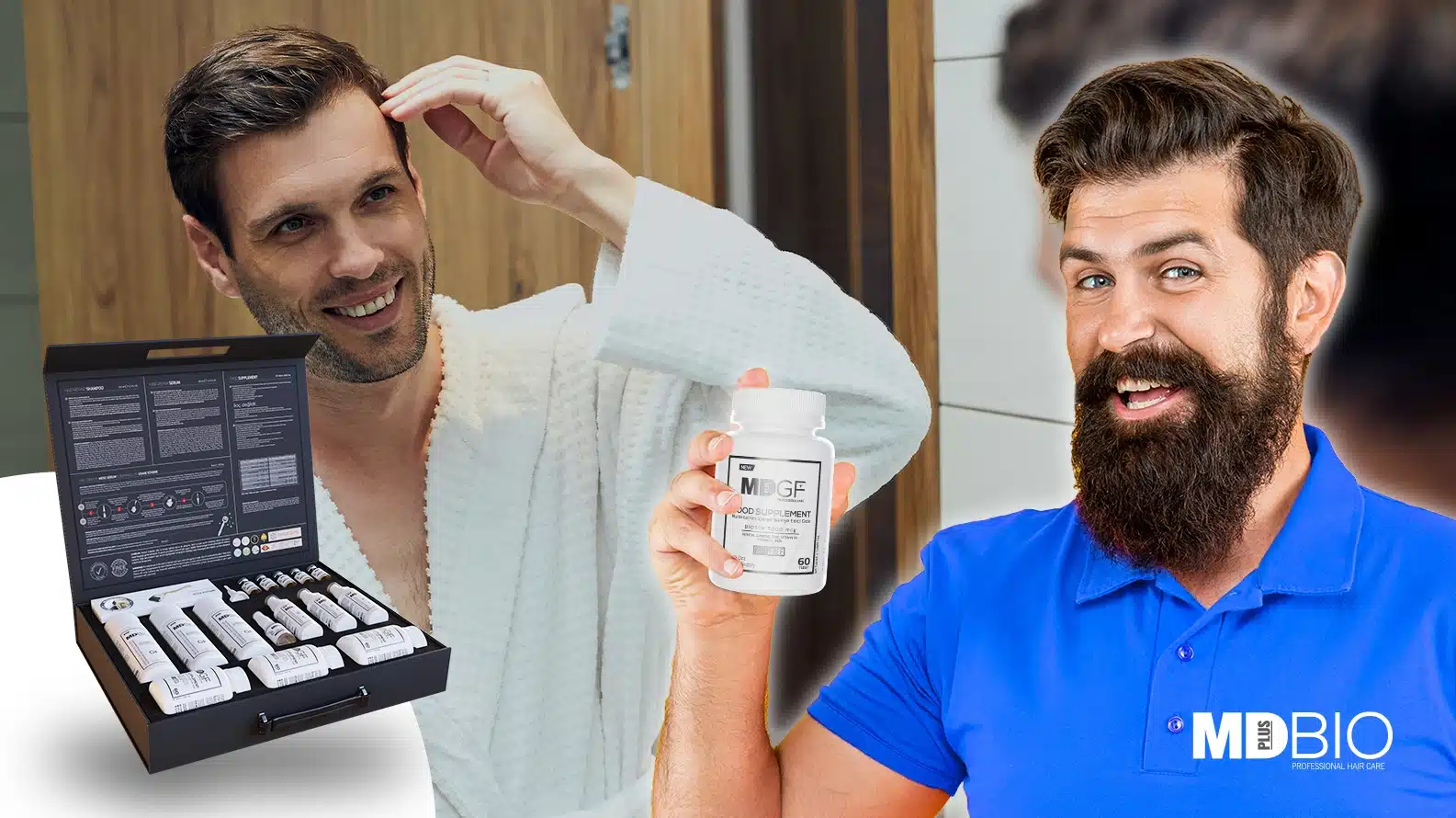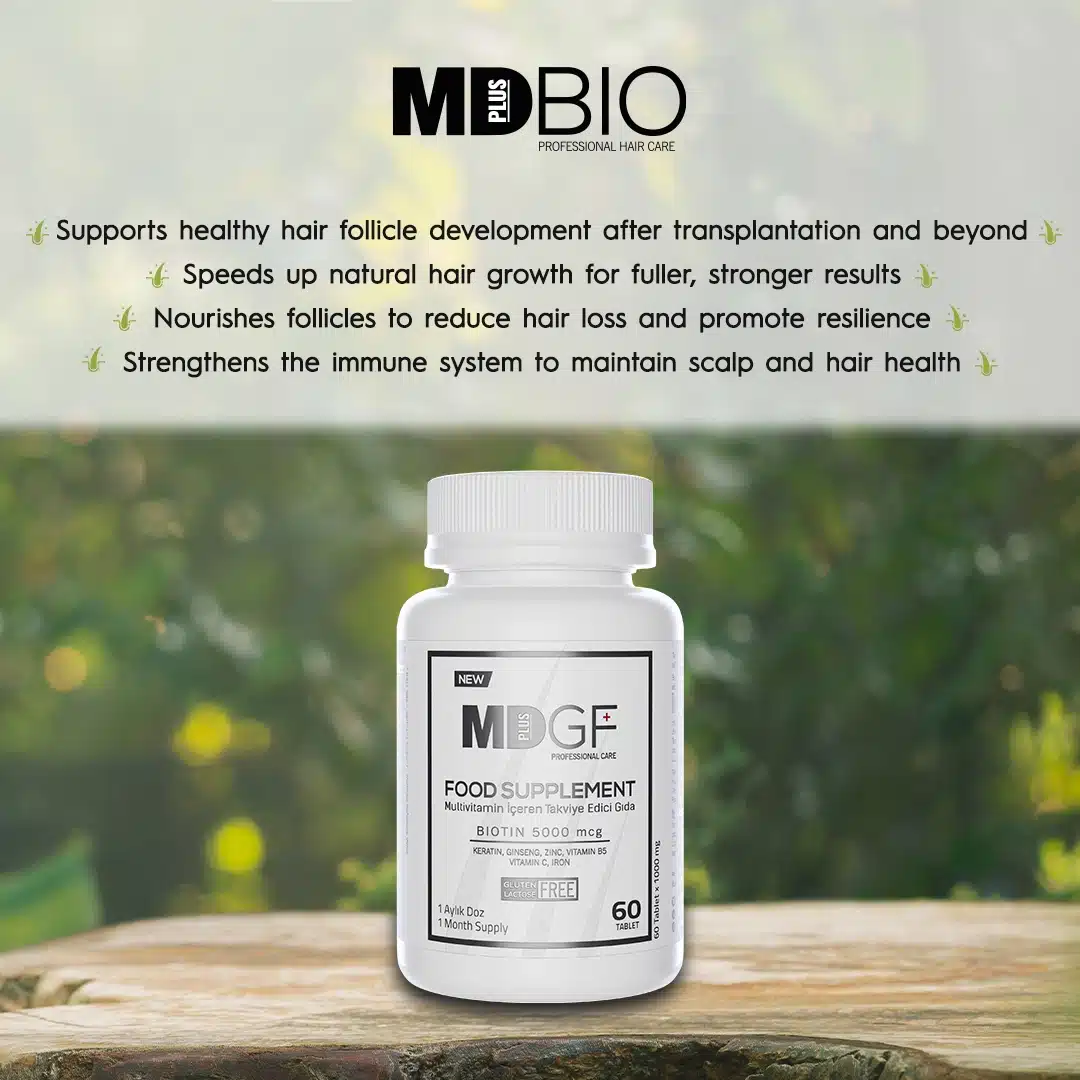Hair transplant? Check.
The hardest part is behind you and the journey to new growth has officially begun.
But what happens next?
Recovery isn’t just about waiting, it’s about
supporting your scalp, protecting the grafts, and giving your new hair the care it needs to thrive.
From the moment you leave the clinic, what you do (and don’t do) makes a big difference in your long-term results.
At MD Plus Bio, we know that the post-op period is just as important as the procedure itself.
That’s why we created this guide to help you recover smarter.
Here, you’ll learn:
- What to expect during each recovery phase
- Essential care tips for post-transplant healing
- The top clinical products to help your hair grow stronger, faster, and healthier
Whether you’re in Day 1 or Month 3, consider this your go-to roadmap to
heal with confidence and make every strand count.
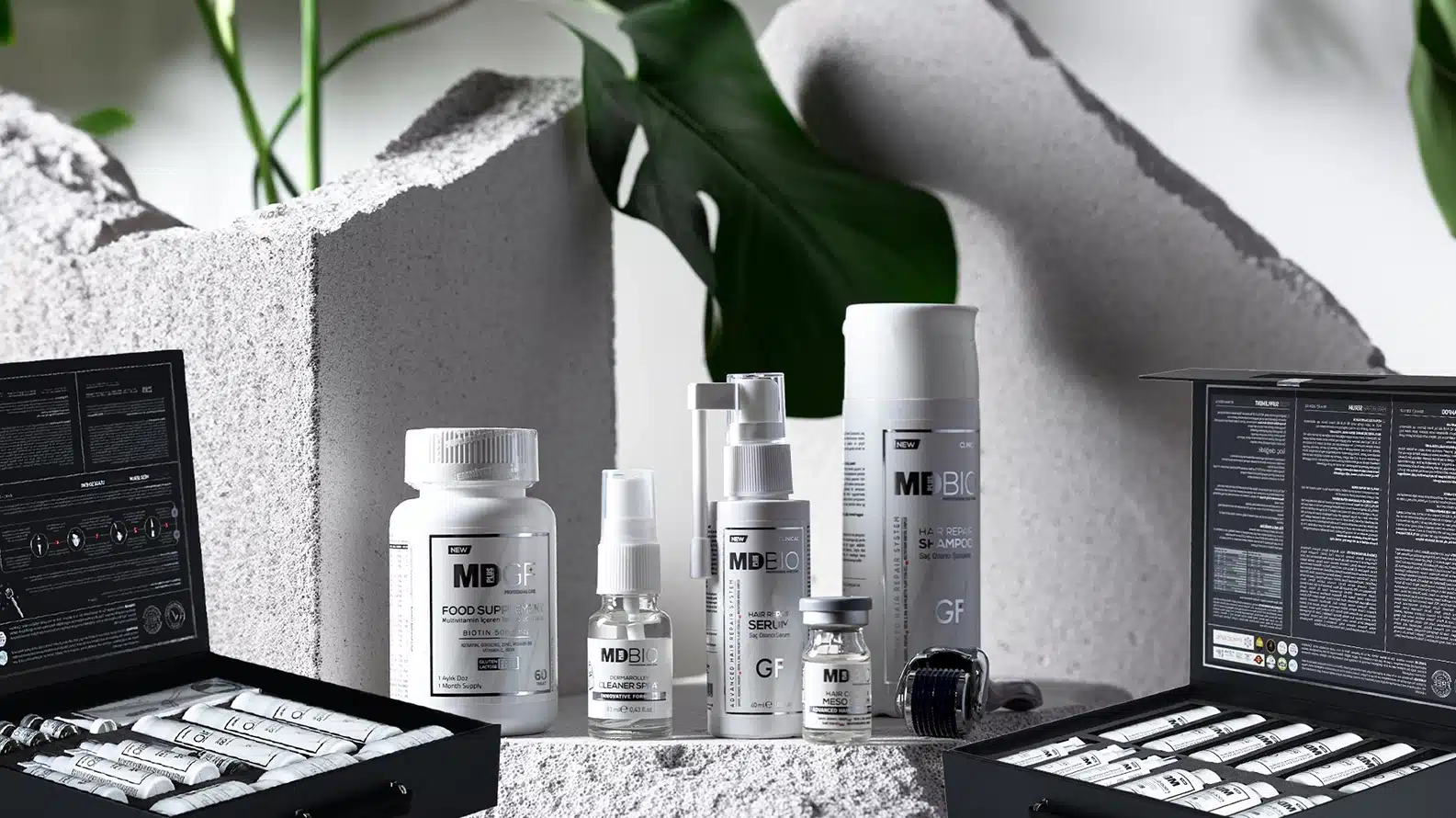
Hair Transplant Recovery Timeline
A successful hair transplant
isn’t just about the procedure, it’s about what comes after. Your scalp goes through a series
of healing phases, each with its own challenges and milestones.
Knowing what to expect during this recovery journey helps you
stay calm, stay consistent, and avoid common mistakes.
While the full regrowth process can take up to 12 months, the first
three months are the most critical for graft survival and scalp health. This is when:
- Scabs form and fall
- Shedding begins (yes, that’s normal)
- New follicles start to activate
- And your long-term results begin to take shape
Let’s walk through what happens day by day, week by week and how you can
support your scalp every step of the way.
Day 1–7: Immediate Post-Transplant Care
The first week after your hair transplant is often the most delicate — both physically and
emotionally. Your scalp is healing. Your grafts are fragile. And it’s completely normal to feel a
bit unsure about what’s happening.
This is the foundation phase of your recovery. Everything you do during these 7
days helps determine how well your new follicles survive, heal, and grow.
What You’ll Likely Experience:
- Redness, swelling, or mild soreness around the recipient and donor areas
- Tiny scabs forming over each graft
- Itching or tightness as the scalp begins to heal
- Sensitivity when sleeping, washing, or wearing anything on your head
- A sense of “Am I doing this right?” — totally normal, and yes, you are.
Your Care Goals This Week:
- Protect the grafts from trauma or infection
- Cleanse gently to reduce buildup and allow healing
- Soothe and hydrate the sensitive scalp
- Reduce swelling and inflammation
What to Use (MD Plus Bio Essentials):
- Repair Foam:
A soothing, non-irritating cleansing foam that helps soften scabs and calm inflammation without disturbing the grafts. - Repair Shampoo:
Ultra-gentle, sulfate-free formula designed to cleanse and nourish the scalp while supporting skin barrier recovery.
Both formulas are free from SLS, parabens, artificial colorants, and other harsh ingredients that can compromise healing.
Best Practices:
- Start washing gently on Day 2 or 3 — only as advised by your doctor
- Pat dry — never rub
- Sleep with your head elevated (1–2 pillows) to reduce swelling
- Avoid sun exposure, sweating, or tight headwear
- Let scabs fall off naturally — never pick or scratch
- Take photos daily if it helps ease your mind — progress often feels invisible in the moment, but you’ll thank yourself later
Pro tip: The first week may look a little messy — that’s okay. Healing is rarely pretty, but it’s powerful.
Week 2–4: Managing the Healing Process
By the second week, the most intense part is over — but this next stage is often where confusion and doubt creep in.
Scabs begin to fall. Shedding may start. Your scalp looks better, but your confidence might take a dip.
Don’t worry — this is all part of the process. What you’re experiencing is controlled chaos beneath the surface, where your follicles are actively shifting into their next growth phase.
What You’ll Likely Notice:
- Most or all scabs fall off (by end of week 2)
- Slight redness may persist in some areas
- The infamous “shock loss” begins — where transplanted hairs shed temporarily
- Itching may continue as new skin forms
- Donor area feels closer to “normal” again
Important: Shedding during this stage is expected. It’s not failure — it’s the follicle resetting. The roots stay. The growth is coming.
What You Should Focus On:
- Staying consistent with your care routine
- Feeding the follicles with the right nutrients
- Calming any lingering inflammation
- Being patient — results are coming, just not visible yet
What to Use (MD Plus Bio Essentials):
- Repair Serum:
Delivers active ingredients like Capixyl, Redensyl, and Plant Stem Cells directly to the scalp,
helping nourish the grafts, support follicle regeneration, and minimize shedding. - Hair Multivitamin Tablets:
Fortified with Biotin, Saw Palmetto, Zinc, and Iron to support internal hair health, hormonal balance,
and immunity — all critical during this reset period.
Think of this stage as watering the roots — even if you can’t see new growth yet, the groundwork is being laid.
Pro Tips:
- Don’t skip washing, even if the scalp looks clean — build-up can block follicles
- Avoid scratching, sun exposure, and sweaty workouts
- Don’t compare yourself to online timelines — every scalp heals differently
- Trust the routine more than the mirror
Pro tip: You’re not regressing — you’re rebooting. Keep going.
Month 1–3: Supporting New Hair Growth
This is where the magic quietly begins.
By now, the healing phase is mostly complete. Your scalp is stronger. The shedding has slowed.
And although it might not look like much on the surface — deep below, your follicles are awakening.
This period is all about nourishing the roots, maintaining consistency, and preparing for
visible regrowth in the months to come.
What You’ll Notice:
- Soft, thin “baby hairs” may begin to emerge
- Growth might look uneven or patchy — totally normal
- Texture may feel different at first (lighter or finer than expected)
- Some follicles may still be dormant — real density takes time
- Most redness and itchiness will have resolved
Don’t expect a full head of hair yet — this is just the initiation phase of regrowth.
What You Should Focus On:
- Supporting vascular health and nutrient delivery to the follicles
- Reinforcing scalp circulation and dermal activation
- Staying consistent with topical and internal treatments
- Building healthy habits — diet, hydration, stress reduction
What to Use (MD Plus Bio Essentials):
- Repair Serum:
Continue twice daily to deliver actives like Procapil, S-DNA, and Plant Stem Cells directly to the scalp. - Hair Multivitamin Tablets:
Strengthens new hair strands from the inside with Biotin, Zinc, Iron, and Ginseng. - Hair Complex Meso Serum
(after 3rd month): Use with Dermaroller to stimulate blood flow and boost product absorption for fuller, stronger growth.
The dermaroller helps awaken dormant follicles by creating microchannels that allow deeper penetration of active ingredients.
Pro Tips:
- Document your progress monthly — not weekly
- Avoid switching products or “giving up” too soon
- Massage your scalp gently to increase circulation
- Celebrate any new growth — even if it’s light or scattered
Pro tip: Think of this as the “root strength” phase. It may not look dramatic, but the structure is building — and results are closer than you think.
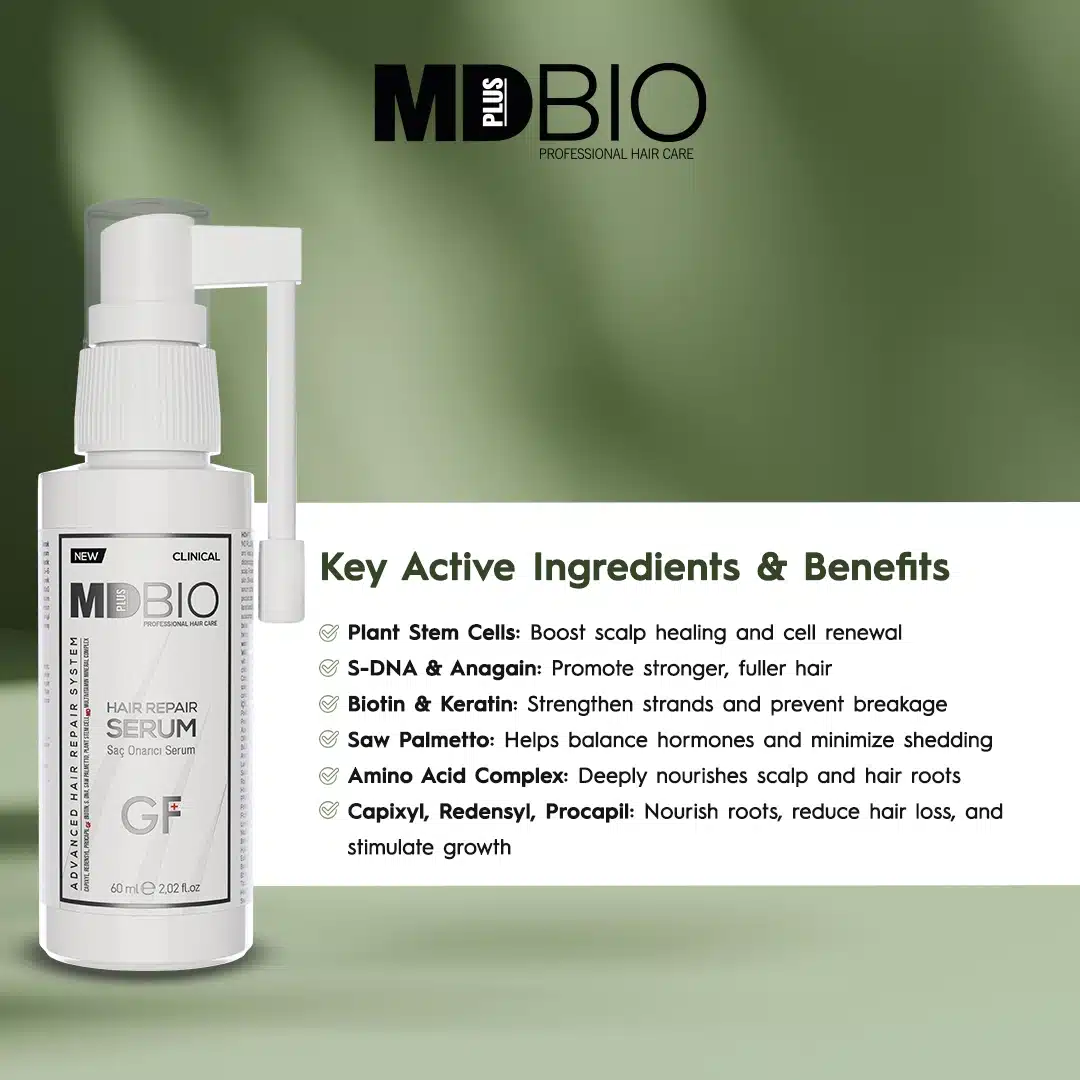
Essential Products for Recovery
The right products can make all the difference during
hair transplant recovery.
From soothing inflammation to supporting follicle growth and preventing hair loss, each phase of healing needs targeted care — and not just any shampoo will do.
That’s why MD Plus Bio Clinical Series was developed: a complete, science-backed line designed to protect grafts, restore scalp balance, and fuel new hair growth from root to tip.
Here’s how each product supports your recovery journey:
Repair Foam
Gentle Cleansing | Scalp Soothing | Scab Removal
A gas-free, non-irritating foam cleanser designed for the sensitive first days after surgery.
It helps dissolve scabs, reduces itchiness, and keeps the scalp clean without disrupting delicate grafts.
- Ideal for: Days 1–10
- Use: Apply before shampooing for best results
Repair Shampoo
Cleansing | Barrier Support | Anti-Irritation
Formulated specifically for post-transplant scalps, this sulfate-free shampoo deeply cleans without stripping or stinging.
With growth factors and plant stem cells, it nourishes and heals from the first wash onward.
- Ideal for: Day 3 onward (once washing is approved)
- Use: Safe for daily use
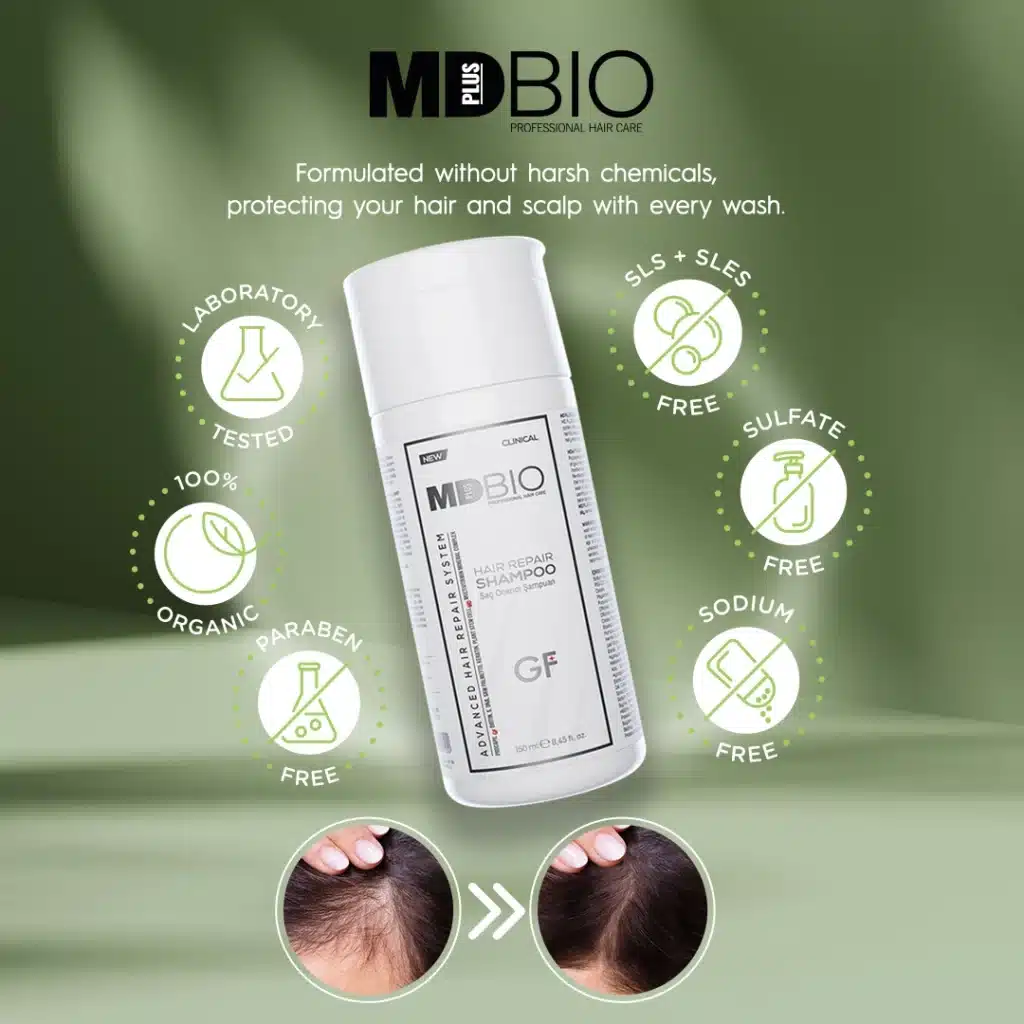
Repair Serum
Follicle Activation | Growth Factor Support | Anti-Shedding
This high-potency serum is your grafts’ best friend. Enriched with Capixyl, Redensyl, Procapil,
and natural DHT blockers like Saw Palmetto, it strengthens roots, reduces shedding,
and reactivates growth cycles.
- Ideal for: Week 2 onward
- Use: Twice daily for optimal results
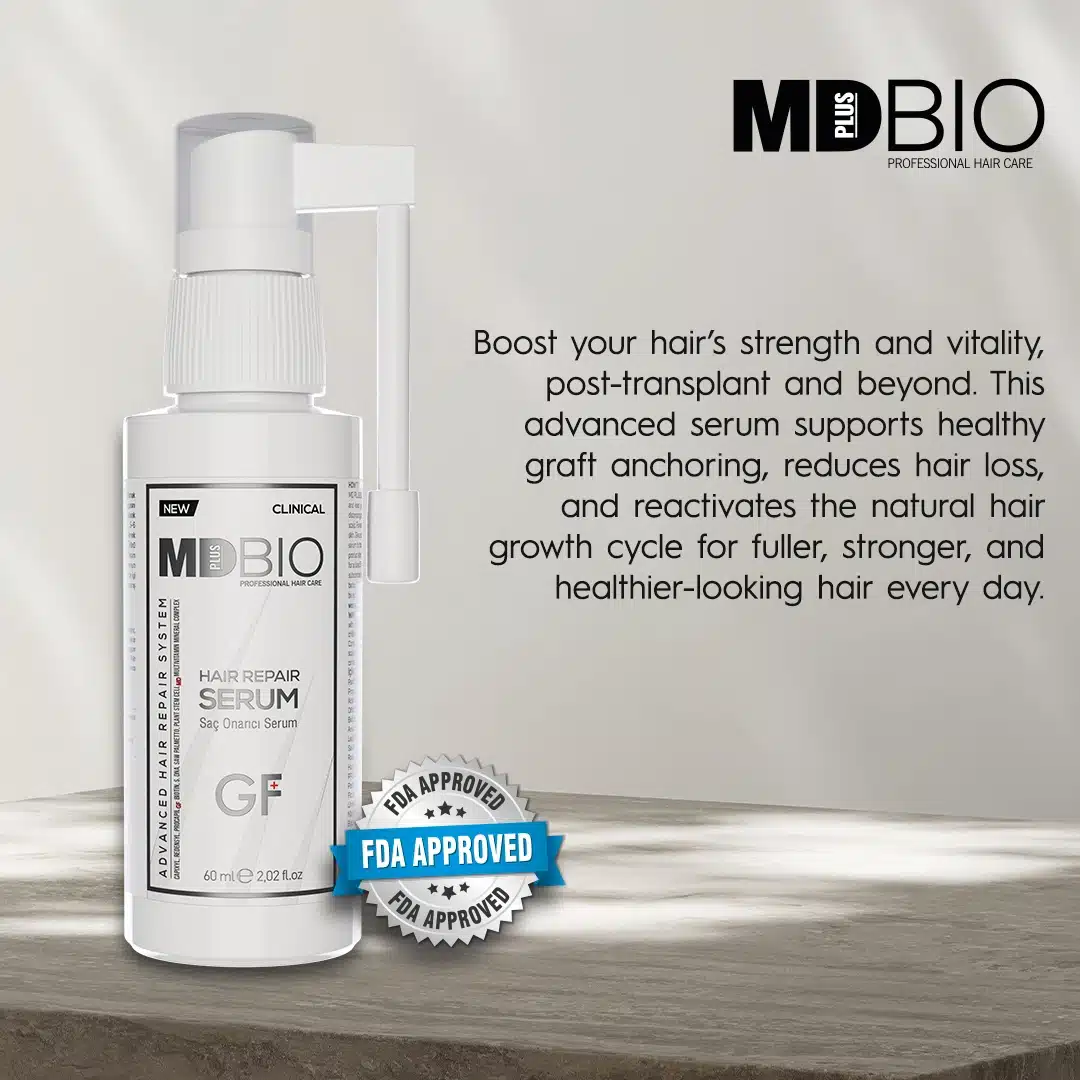
Hair Multivitamin Tablets
Internal Nutrition | Root Strength | Hormonal Balance
Hair health starts from within. These daily supplements deliver Biotin, Keratin, Zinc, Iron,
Ginseng, and more to support the body’s hair growth process — especially during the shedding and regrowth phases.
- Ideal for: All recovery phases
- Dosage: Men: 2× daily | Women: 1× daily
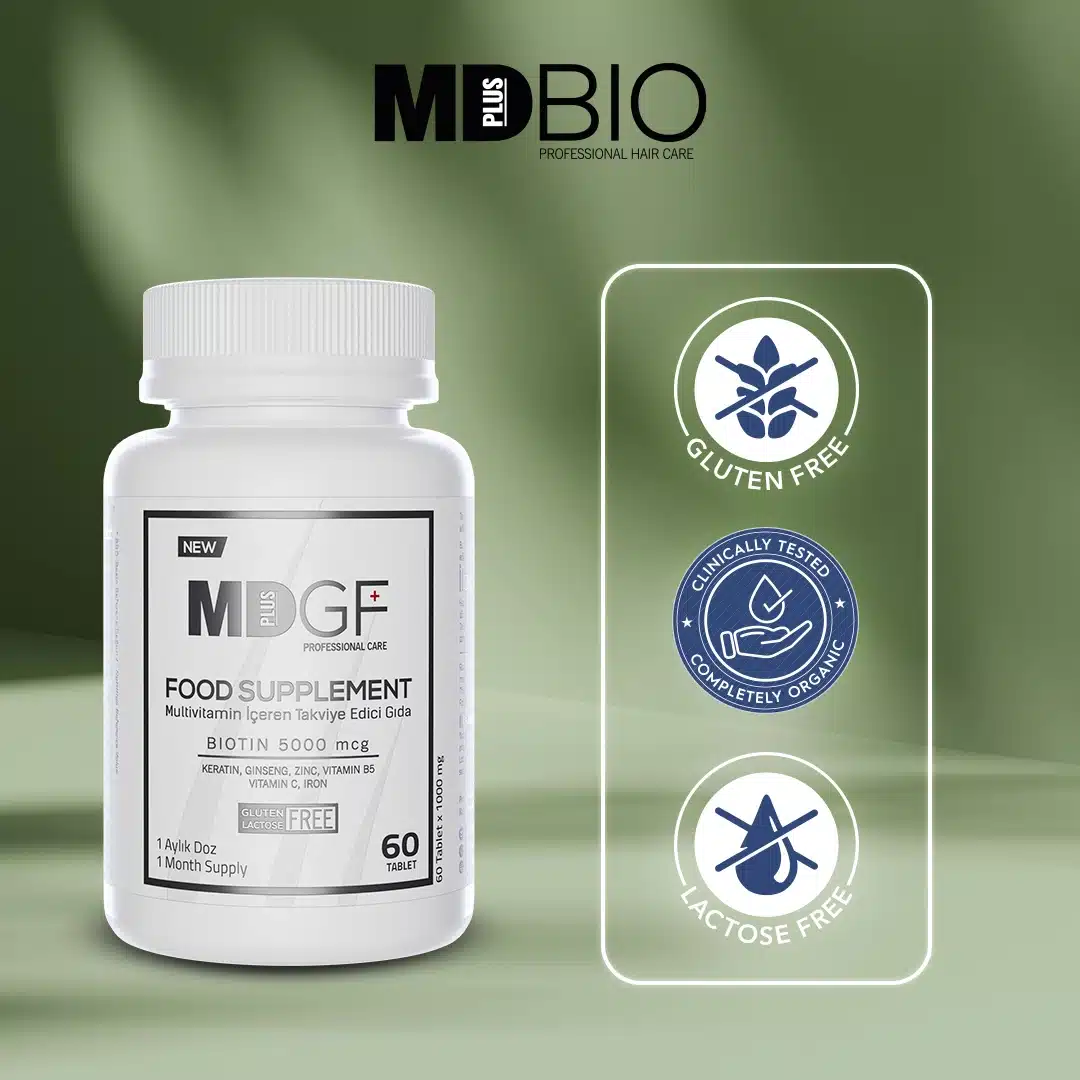
Hair Complex Meso Serum + Dermaroller
Deep Stimulation | Density Boost | Long-Term Growth
Beginning around Month 3, this intensive care duo revives dormant follicles and accelerates visible growth.
Use the dermaroller to increase blood flow and product absorption, then apply the Meso Serum for high-impact regeneration.
- Ideal for: Month 3+
- Use: 1–2× per week
Pro tip: Use a clean, disinfected dermaroller each time to avoid irritation or infection.
Common Mistakes to Avoid
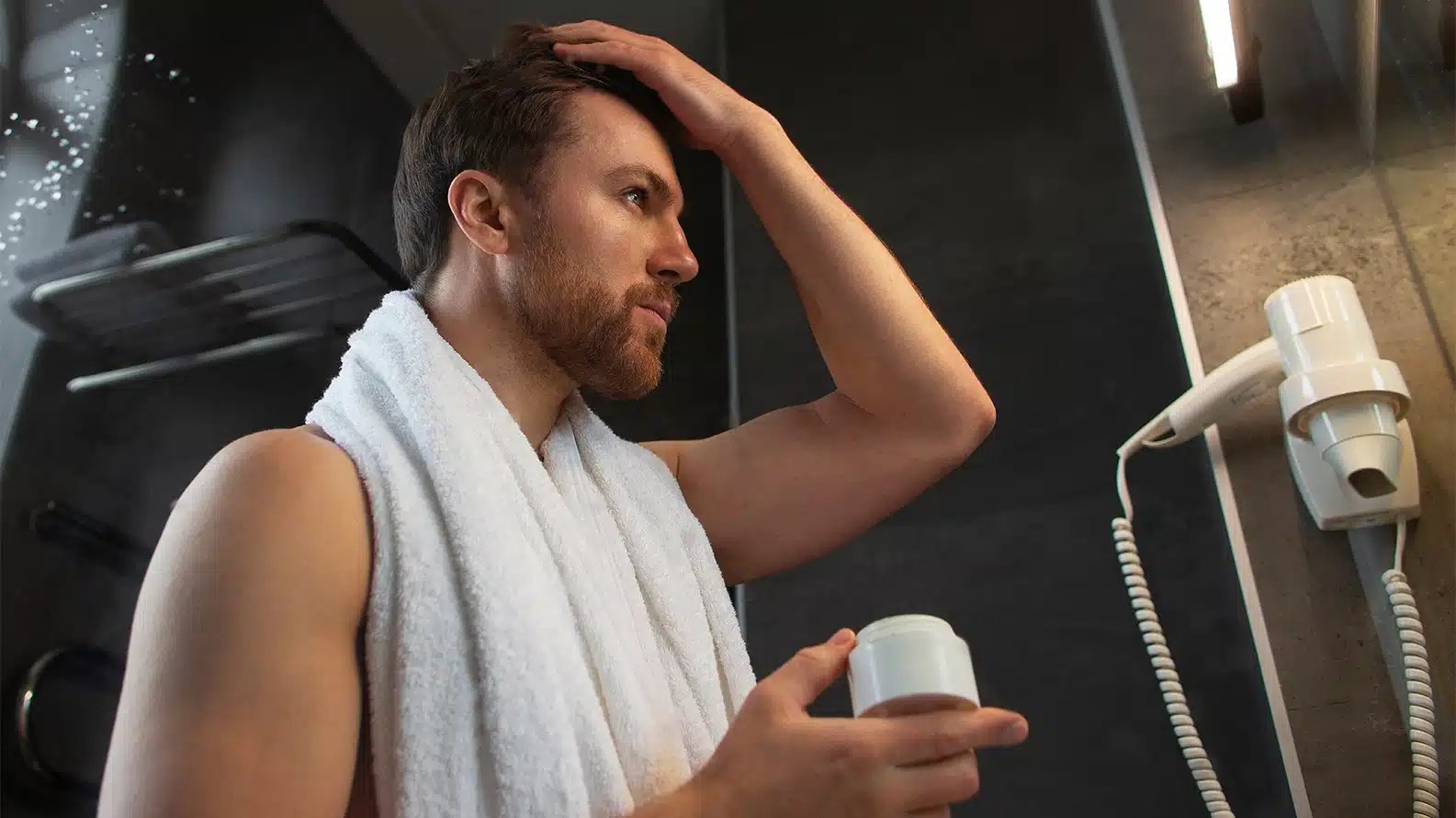
Even with the best intentions, it’s easy to make a few missteps during your recovery.
But don’t worry — most are preventable. By being aware of what not to do, you’ll give your scalp the safest, most effective path to long-term results.
Here are the top mistakes to avoid after a hair transplant:
- Picking at Scabs
We get it — they’re itchy. But picking can dislodge grafts and leave scars.
Do this instead: Let scabs fall naturally with gentle cleansing products like Repair Foam.
- Using Harsh Shampoos
Standard shampoos often contain sulfates, alcohols, or strong fragrances that irritate healing skin.
Do this instead: Choose a post-op formula such as Repair Shampoo to protect your scalp barrier.
- Skipping Your Routine
Consistency is key. Even if progress seems slow, your follicles need steady support.
Do this instead: Stick to your daily regimen of serum, vitamins, and gentle cleansing — results will come.
- Expecting Instant Results
Hair takes time to grow — especially after surgery. Impatience can lead to frustration or switching products too early.
Reality check: Most visible results appear between Month 4–6, with full results at 12+ months.
- Ignoring Internal Health
Hair doesn’t just grow from the outside. Poor diet, stress, or vitamin deficiencies can slow healing and growth.
Do this instead: Support your body with Hair Multivitamin Tablets, hydration, and rest.
- Skipping Professional Advice
If you’re unsure about a symptom, shedding pattern, or product timing — ask your specialist.
Why it matters: Recovery isn’t one-size-fits-all, and expert guidance makes a difference.
Final Thought: Your recovery is a marathon, not a sprint. By avoiding these common mistakes and staying consistent with your care, you’re giving every graft its best chance to thrive.


